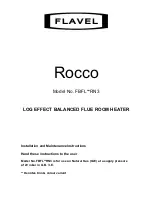
25
START-UP CONDITIONS
DRAFT HOOD OPERATION
Check draft hood operation by performing a worst case
depressurization of the building. With all doors and
windows closed, and with all air handling equipment and
exhaust fans operating such as furnaces, clothes dryers,
range hoods and bathroom fans, a match flame should
still be drawn into the draft hood of the water heater
with its burner firing. If the flame is not drawn toward the
draft hood, shut off water heater and make necessary air
supply changes to correct.
CONDENSATION
Whenever the water heater is filled with cold water, some
condensate will form while the burner is on. A water
heater may appear to be leaking when in fact the water is
condensation. This usually happens one of the following
occurs:
A.
A new water heater is filled with cold water for the first
time.
B.
Burning gas produces water vapor in water heaters,
particularly high efficiency models where flue temperatures
are lower.
C.
Large amounts of hot water are used in a short time and
the refill water in the tank is very cold.
Moisture from the products of combustion condense on
the cooler tank surfaces and form drops of water which
may fall onto the burner or other hot surfaces to produce
a “sizzling” or “frying” noise.
Excessive condensation can cause pilot outage due to
water running down the flue tube onto the main burner
and putting out the pilot.
CHECKING GAS INPUT
With this heater in operation, determine whether it is
receiving the full rated input of gas. This may be done by
timing the gas meter and measuring gas pressure with a
gauge or manometer. When the heater is operating at full
capacity (full gas input) it should consume approximately
1 cubic foot of gas in the time shown in Table 5.
TABLE 6. INPUT CHECK TIME REQUIRED TO CONSUME 1
CU. FT. OF GAS
Model
Type of Gas
BTU Per
Cu. Ft.
Approx. Time Required To
Consume 1 Cu. Ft. of Gas
75
Natural
Propane
1050
2500
50.3 sec. 119. 8 sec.
100
Natural
Propane
1050
2500
50.3 sec. 119.8 sec.
Use this formula to “clock” the meter. Be sure that other
gas consuming appliances are not operating during this
interval.
3,600 X H
= Btu/Hr
T
T = Time in seconds needed to burn one
cubic foot of gas.
H = Heating value of gas in Btu’s per cubic foot of gas.
Btu/Hr = Actual heater input rate.
Example:
T = 50.3 seconds/ft3
H = 1,050 Btu/ft3 (natural gas)
Btu/Hr = ?
3,600 X 1,050
= 75,100 Btu/Hr (22.0 kW)
50.3
Compare the actual input rate to that given on the
heater’s rating plate. In the example, the full input rate
should be 75,100 Btu/Hr for natural gas.
Because of the suddenness and amount of water,
condensation water may be diagnosed as a “tank leak”.
After the water in the tank warms up (about 1-2 hours),
the condition should disappear.
Do not assume the water heater is leaking until there has
been enough time for the water in the tank to warm up.
An undersized water heater will cause more
condensation. The water heater must be sized properly
to meet the family’s demands for hot water including
dishwashers, washing machines and shower heads.
Excessive condensation may be noticed during the
winter and early spring months when incoming water
temperatures are at their lowest.
Good venting is essential for a gas fired water heater
to operate properly as well as to carry away products of
combustion and water vapor.
FOR YOUR INFORMATION
Summary of Contents for BT-100-LP
Page 45: ...45 NOTES ...
Page 47: ...47 ...
















































